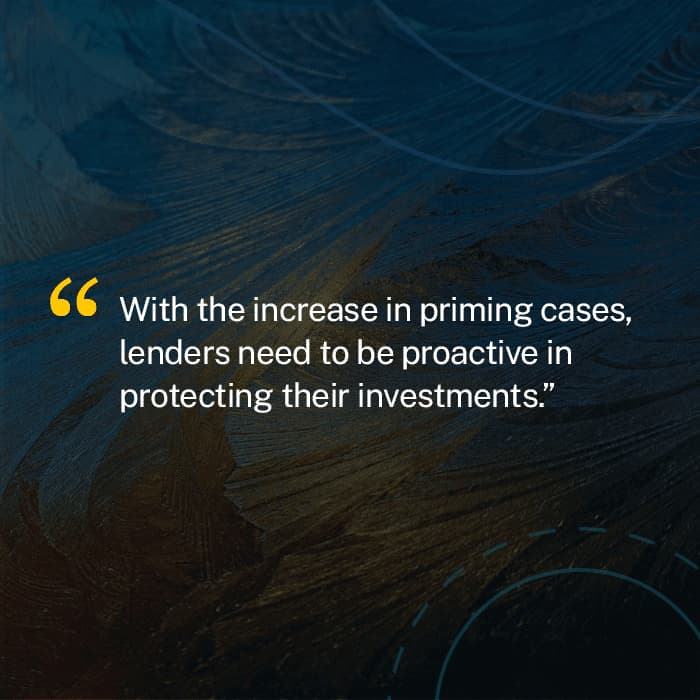
Amid financial stress, a company may need additional liquidity to shore up its balance sheet to avoid covenant defaults under its existing loan agreement. If a company is already overleveraged, it may need to find creative ways under its existing debt agreements to allow for a new loan using its existing collateral as security. Lenders in the new loan will likely require a senior priority lien on the company’s collateral. As a result, all existing loans are “primed” when their liens against the collateral are surpassed by the new loan. Most collateral priming transactions tend to fall under two mechanisms—documentation loopholes or amendments. Under the first, a company uses a loophole within the terms of their loan agreement to allow it to take on additional senior debt secured by collateral already pledged under a separate credit facility. With an amendment, the company works with requisite lenders to amend the existing loan documents to allow for a new senior loan facility and often “uptier” the existing facility as a result.
Cheaper financing available to borrowers in 2022 enabled companies and lenders to negotiate looser covenant packages. Now, lenders are seeking to retrieve money from struggling companies while borrowers are desperate to lower interest costs and raise additional debt to withstand the current financial landscape. Regardless of which path is taken, the outcome often puts majority and minority lenders at odds, creates tension with the company, and may result in legal action. While collateral priming disputes are not new, the loan market had seen an uptick during 2020 as more companies struggled during the worldwide COVID-19 pandemic and more uptiering transactions are likely to emerge going forward.
We will review each of these uptiering transaction scenarios and look at recent disputes under both. In addition, we will highlight what lenders can do to mitigate being on the wrong side of a collateral priming event.
Uptiering Loopholes
In these instances, a company will move collateral away from existing lenders, so it can be used to secure new or restructured debt by utilizing existing carveouts and investment language in their loan documents. Typically, a company will bring in new lenders to fund this loan, and existing lenders are primed. J. Crew, Travelport, Neiman Marcus, and PetSmart are examples of transactions where a company successfully used existing documentation loopholes that resulted in an uptier transaction.
“Pulling a J. Crew”1
In 2016, J. Crew2 used loopholes in its term loan agreement to move more than 70% of its IP assets from a restricted subsidiary to an unrestricted subsidiary. This action stripped the term loan lenders of that IP collateral and allowed J. Crew to use the now unencumbered IP assets as collateral for additional debt. This transaction has become synonymous with collateral priming, and similar transactions are often referred to as “pulling a J. Crew.”
Since J. Crew, other companies have attempted similar transactions. In early 2020, Travelport3 moved IP collateral to unrestricted subsidiaries, only to unwind the assignment later in the year as part of an overall transaction that restructured its existing debt and raised new capital to help the company weather through the COVID-19 pandemic.
Collateral Priming Amendments
Aside from loopholes, companies will also look to amend their existing loan agreements to allow for restructuring of their existing debt and/or raise additional capital. Certain amendments will require 100% lender consent, but those scenarios are limited to sacred rights under the agreement. The majority of terms in a loan agreement can be amended with requisite lender consent. It is those scenarios that sometimes pit lender against lender, especially if certain lenders were excluded from amendment discussions.
Example: Serta Simmons
In Serta Simmons4, certain lenders challenged a June 2020 financing that provided the company with $200M of new capital and primed the company’s existing first- and second-lien term loan facilities. Serta, which needed liquidity, moved certain trademarks it owned into a subsidiary outside the reach of the existing first- and second-lien facilities. It then used the trademarks as collateral for new debt, which raised $200M in new capital and swapped some of its existing first- and second-lien debt. With the debt swap, the refinancing slashed the company’s overall debt by $400M.5
Minority lenders in Serta’s existing term loans filed a motion attempting to bar the new financing from moving forward by claiming that the deal improperly subordinated their loans. The Supreme Court of the State of New York issued a decision rejecting the minority lenders’ motion, and the deal moved forward. The Court held that the release of collateral did not require 100% lender approval. Only a simple majority of lenders’ consent was required under the terms of the loan documents.
Since the Serta Simmons decision, similar transactions have emerged. An ad hoc group of first-lien lenders challenged Boardriders6 on an August 2020 financing that provided the company with $110M in fresh capital and primed the company’s existing loans. The company needed liquidity to help fund ongoing operations and to keep it afloat. An amendment to the existing credit agreement enabled the company to exchange part of its existing debt for a senior loan facility and secure new money. The ad hoc lender group argued that the private rollup transaction deprived the non-participating lenders of their bargained first-lien priority, subordinated their debt, and left them with a stripped-down loan agreement, among other claims.
In September 2020, an ad hoc group of TriMark7 lenders sought advice on whether to challenge a new super-priority, non-pro rata term loan provided by majority lenders that uptiered the ad hoc group.
Some wonder whether this is the new normal and if we will continue to see these types of priming loan events. However, in each of these scenarios, it comes down to the terms in the original loan documents, whether that involves loopholes found in various covenant sections or the ability of majority lenders to allow collateral releases and other forms of restructuring the debt via amendment.
Protecting Lenders from Uptiering
With the increase of recent priming cases, lenders need to be proactive in protecting their investments. The team at SRS Acquiom offers ideas to help lenders remain vigilant in the wake of these practices.
Review Existing Credits
Lenders should review their existing credits and understand whether language exists in an agreement that could allow the company to prime their loan—whether by using existing investment buckets, covenant carveouts, unrestricted subsidiaries or other loopholes. This step may seem obvious, but it is crucial to understand what is in your loan document before you can begin assessing potential risk.
Lenders may feel the need to close a potential loophole. In some instances, they may want to require 100% lender consent for any collateral release or bar exchanging lenders from consenting to an amendment that would make the exchange possible. However, lenders should look at the broader context before pushing for such amendment.
Many of these provisions have been in credit agreements for decades and are considered market standard. In addition, loopholes are not always a bad thing. They can be quite useful when a borrower is trying to keep its business alive and needs additional financing. A loophole can be the key to keeping a company out of bankruptcy. Before a lender starts campaigning to close loopholes in their credit agreements, they should consider all relevant factors for their investment.
Monitor Your Credits
Lenders should continually monitor their credits, looking for signs of distress. They should always be on the offense. If liquidity becomes an issue, be the first one to the table. Stay connected with the company’s sponsor. Bottom line: know what is happening with your companies, and always be a part of the solution when an issue arises.
Enhance Front-End Due Diligence
Before even entering a deal, be sure to vet the company and other parties involved. Look at the sponsor: what is their investment model, are they litigious, do they play more “offense or defense” in the markets they serve? Parties will often use the same playbook over and over. Look for trends in their prior investments.
In addition to a careful review of the deal parties, be sure to review all loan documents. Understand the amendment language, clauses on additional debt, the negative covenant, and more. Due diligence on the front end does not replace ongoing credit monitoring, but it will identify key flags.
Predatory Practices in Uptiering: Likely Here to Stay
The complexion of the loan market is changing, with the rise in uptiering/priming transactions and the increase in direct lending. This will likely produce challenging situations for company sponsors and lenders alike for the foreseeable future. The team at SRS Acquiom will continue to monitor the effects on the transactions it sees. Lenders can never mitigate all risk in a transaction. But by monitoring credits, identifying loopholes, and being proactive, lenders can take the necessary steps to limit exposure to a priming event.
Challenging market conditions will ebb and flow against the wider macroeconomic backdrop and company sponsors and lenders alike will face additional challenges for the foreseeable future. The team at SRS Acquiom will continue to monitor the effects on the transactions it sees. Lenders can never mitigate all risk in a transaction. But by monitoring credits, identifying loopholes, and being proactive, lenders can take the necessary steps to limit exposure to a priming event.
Take a Deeper Dive
Explore our accompanying checklist Predatory Uptiering: Three Steps to Protect Against Being Primed for strategies lenders can use to protect themselves against uptiering transactions.
Footnotes:
1 Debtwire, May 28, 2020, Cirque du Soleil’s J. Crew-style financing pits TPG-led equity holders against senior lenders, by Richard M. Goldman.
2 Eaton Vance Management et al. v. Wilmington Savings Fund Society, FSB, as Administrative Agent and Collateral Agent et al., Index No. 654397/2017 (Sup. Ct. NY, Sept 7, 2017).
3 Debtwire, September 28, 2020, Travelport lenders tout new covenant restrictions, collateral retention as bilateral victory, by Reshmi Basu.
4 North Star Debt Holdings et al. v. Serta Simmons Bedding, LLC et al., Index No. 652243/2020 (Sup. Ct NY, June 16, 2020).
5 Debtwire, June 21, 2020, COURT: Serta Simmons minority lenders can’t halt debt swap, judge rules, by Maria Chutchian.
6 ICG Global Loan Fund 1 DAC et al. v. Boardriders, Inc. et al., Index No. 0655175/2020 (Sup. Ct NY, October 9, 2020).
7 Audax Credit Opportunities Offshore Ltd. Et al. v. TMK Hawk Parent, Corp et al., Index No. Unassigned (Sup. Ct NY, November 7, 2020).

Renee Kuhl
Managing Director, Loan Agency tel:612-509-2323
Renee is the managing director of the SRS Acquiom Loan Agency Group. With more than 15 years of experience as administrative and collateral agent on loan transactions and more than ten years managing teams in loan agency and restructuring products, she is an accomplished financial industry professional and leads the loan agency business globally.
Before joining SRS Acquiom, Renee served as an administrative vice president at Wilmington Trust, N.A., most recently leading the loan agency and restructuring products. In addition to her 10 years at Wilmington Trust, she also worked for Wells Fargo Bank, N.A. in the corporate trust and shareholder services departments.
Renee has a Juris Doctorate from Mitchell Hamline School of Law in Minnesota, and a B.A. in political science and history from Azusa Pacific University in Azusa, California.